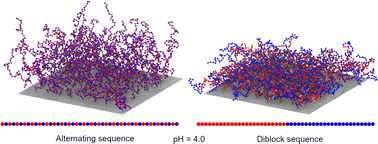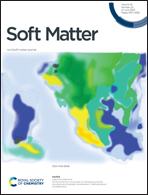pH response of sequence-controlled polyampholyte brushes†
Abstract
We use molecular simulation to investigate the pH response of sequence-controlled polyampholyte brushes (PABs) with polymer chains consisting of alternating blocks of weakly acidic and basic monomers. Changes in the ionization state, height, lateral structure, and chain conformations of PABs with pH are found to differ qualitatively from those observed for polyelectrolyte brushes. Grafting density has a relatively modest effect on PAB properties. By contrast, monomer sequence strongly affects the pH response, with the extent of the response increasing with the block size. This trend is attributed to strong electrostatic attractions between oppositely charged blocks, which lead to an increase in chain backfolding as block size increases. This behavior is consistent with that observed for polyampholytes with similar monomer sequences in solution in previous studies. Our study shows that monomer sequence can be used to tune the pH response of weak PABs to generate stimuli-responsive surfaces.



 Please wait while we load your content...
Please wait while we load your content...